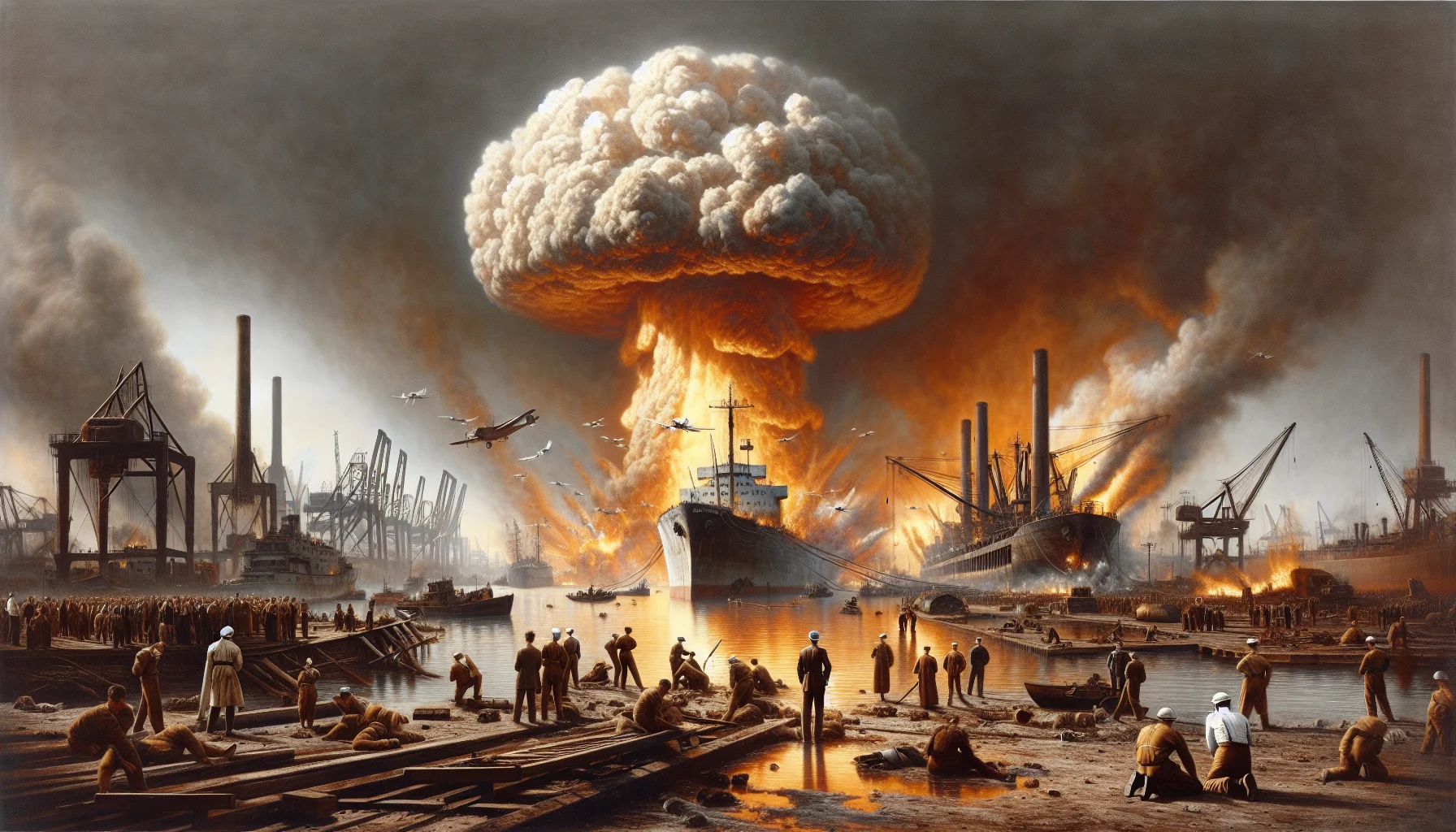
Texas City Disaster
by: The Calamity Calendar Team
April 16, 1947
It began as just another day in the bustling port city along the Gulf Coast of Texas. Workers and residents of Texas City were no strangers to the rhythms of industrial life, the hum of industry a constant backdrop. But on April 16, 1947, this routine was shattered by an event that would leave an indelible mark on history — the Texas City Disaster.
Introduction
The morning sky over Texas City was unremarkable, a typical canvas for a Gulf Coast sunrise. Yet, hidden within this comfortable monotony, something perilous was quietly brewing aboard the SS Grandcamp, a massive cargo ship docked at the port. That day, whispers of smoke and signs of fire would set off a chain of events so destructive, the repercussions would be felt far beyond the boundaries of this coastal town.
Lead-Up and Background
Texas City, like many post-war American cities, thrived on industry and trade. Its port, one of the busiest in the nation, was lined with ships, warehouses, and factories processing everything from oil to chemicals. The SS Grandcamp was an emblem of this boom — a repurposed wartime Liberty Ship now tasked with a civilian mission: transporting goods.
Among the cargo was approximately 2,300 tons of ammonium nitrate, a common agricultural fertilizer with a volatile importance in munitions manufacturing. While practical, this cargo was a ticking time bomb, defined by its capacity for catastrophe should conditions, such as temperature and handling, stray from safety norms.
The Event
The initial stirrings of the disaster were humble. On the prior day, dock workers had finished loading the volatile ammonium nitrate onto the Grandcamp, oblivious to the threat simmering beneath the surface. As dawn on April 16, 1947, unfurled, crew members noticed smoke and initiated customary fire protocols. There was no panic; instead, an unfortunate confidence in routine measures that would soon betray them.
At 9:12 a.m., as onlookers gathered to observe the curious scene, the fire's true nature revealed itself with a deafening explosion. The ammonium nitrate erupted, not unlike a volcano of shrapnel and flame, sending a shockwave across Texas City and farther still, with reports of sensation as remote as Louisiana. A towering mushroom cloud climbed the sky, a monstrous reminder of human error and nature's fury.
Thanks for subscribing!
That single explosion triggered a cascade of destruction — ignition spread from ship to shore, engulfing everything from oil reserves to other ships in a merciless dance of combustion. Desperation reigned as further explosions rocked the community, turning the thriving industrial hub into a charred wasteland.
Aftermath and Consequences
Texas City was transformed into a scene of tragic ruin. Close to 600 lives were hastily claimed, each a narrative of lost potential and abrupt goodbyes. The damage to property was staggering, amounting to what would today be valued at over a billion dollars. The disaster rendered the port and much of the city a tortured landscape of loss and ruin.
Injuries were rampant — a grim testament to a single day’s brutality, with approximately 5,000 people hurt, and homes across the city lay decimated. Thousands found themselves suddenly without shelter, amid the raw aftermath of a world turned upside down.
Response, Recovery, and Resolution
The response was immediate, though compromised by the scale and chaos of the event. Texas State National Guards movilized, efforts hampered by the very ruins they hoped to navigate. Rescue and recovery required national resolve, pushing President Harry S. Truman to dispatch military units and oversee a fund-raising initiative for those affected.
This catalyst of tragedy prompted a reevaluation of industrial protocols, especially concerning hazardous materials. Regulations were tightened and redefined, aiming to prevent future calamities from similar sources.
Legacy and What We Know Now
The Texas City Disaster stands among history's grim reminders, echoing beyond its immediate toll into broader regulatory and safety landscapes today. It served as a pivotal learning point, enhancing modern understanding of materials like ammonium nitrate and honing in on the critical logistics of storage and transportation safety. The tragedy, while unmatched in its harshness, now aids in safeguarding communities globally against similar fates.
As time marches on, the lessons borne from the destruction of April 1947 continue to resonate, etching the memory of Texas City's darkest day into the chronicles of industrial history — both as a warning and a guiding light for future diligence.
Stay in the Loop!
Become a Calamity Insider and get exclusive Calamity Calendar updates delivered straight to your inbox.
Thanks! You're now subscribed.